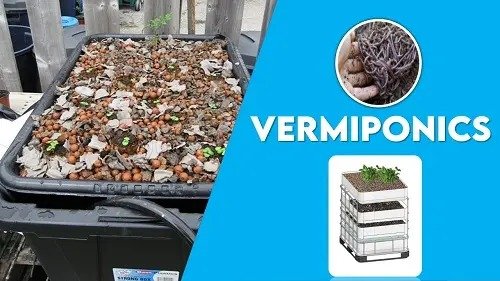Vermiponics : An Alternative To Hydroponics

It has become more challenging to set aside land for farming due to growing urban sprawl, which is turning rural villages into urban villages and increasing land shortages in cities. Innovative farming techniques like vermiponics and aquaponics can be used vertically indoors in this situation to ensure food security as an alternative to conventional urban farming methods.
What is Vermiponics
Vermiponics is a soil-free proactive action that integrates hydroponics and vermiculture by using diluted worm bin leach solution (“worm tea”) as the nutrient solution.
Because it relies less on artificial fertilisers and employs natural processes to fertilise plants, vermiponics is regarded as a sustainable and environmentally beneficial technique for growing plants. Due to internal water recirculation and reuse, it also reduces the amount of water used. Additionally, vermiponics can produce both fish and vegetables, providing a sustainable source of protein and fresh produce.
why vermiponics gaining popularity
Vermiponics is gaining popularity globally for several reasons:
- Sustainable agriculture: Vermiponics is a sustainable method of agriculture that minimizes waste and uses natural processes to grow plants. It reduces the need for chemical fertilizers and pesticides, and it recirculates water, minimizing water use.
- High-quality produce: Vermiponics can produce high-quality, nutrient-dense produce, as the plants are grown in a controlled environment and receive a consistent supply of nutrients.
- Increased food production: Vermiponics can increase food production in areas where traditional agriculture is limited due to poor soil quality or lack of space. It can be set up in urban areas, providing fresh produce to local communities.
- Reduced carbon footprint: Vermiponics has a smaller carbon footprint compared to traditional agriculture, as it reduces the need for transportation and uses less water and energy.
- Technological advancements: Technological advancements have made vermiponics more accessible and cost-effective. With advancements in sensors, automation, and software, vermiponics can be monitored and managed remotely, reducing labor costs and increasing efficiency.
case studies of vermiponics system
There are several case studies and examples of successful vermiponics systems in various settings around the world. Here are a few examples:
- University of Hawaii at Manoa: The university has a vermiponics system that uses vermicompost to grow lettuce and other vegetables. The system has demonstrated a reduction in water use and improved plant growth compared to traditional hydroponic systems.
- Blue Barrel Farm: Blue Barrel Farm in Colorado uses a vermiponics system to grow vegetables for local markets. The system uses vermicompost and worms to break down organic matter and provide nutrients to the plants.
- Ithaca Children’s Garden: The Ithaca Children’s Garden in New York has a vermiponics system that grows a variety of vegetables and herbs. The system uses fish waste and vermicompost to provide nutrients to the plants, and has been successful in producing high-quality crops.
- Nanyang Technological University: The university in Singapore has developed a vermiponics system that uses worms to break down food waste and produce nutrient-rich vermicompost. The system is used to grow vegetables and herbs for the university’s dining hall.
- International Rice Research Institute: The institute in the Philippines has developed a vermiponics system for rice cultivation. The system uses vermicompost to provide nutrients to the rice plants, and has been successful in improving yields and reducing the need for chemical fertilizers.
future prospects of vermiponics
As awareness of the environmental and economic benefits of vermiponics grows, it is likely that more farmers and urban growers will adopt this technology. This could result in increased food production, improved soil health, and reduced environmental impact. As vermiponics technology continues to evolve, we may see new innovations that further improve nutrient delivery, water use efficiency, and disease resistance. This could lead to more sustainable and efficient food production. As more research is conducted on vermiponics, we may gain a better understanding of its potential benefits and limitations. Governments around the world may provide policy support for vermiponics and other sustainable agriculture practices
This Article is taken from Times of agriculture magazine authored by Reetika Sharma
Join Times of Agriculture
Get the latest Agriculture Magazine and regular important updates right on your phone.
👉 Join WhatsApp Group